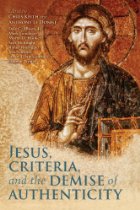 Continuing from Historical Method versus Jesus Research: Chapter 2 of Jesus, Criteria and the Demise of Authenticity. . . .
Continuing from Historical Method versus Jesus Research: Chapter 2 of Jesus, Criteria and the Demise of Authenticity. . . .
Jens Schröter reminds us of flaws with the criteria approach to find the historical Jesus. They encapsulate what I have covered in my posts on Chris Keith’s chapter one:
- Criteria were designed as a tool to assist with form criticism
- Form criticism assumed that Gospels could be peeled apart layer by layer to find sections originating with the Church, sections originating with Judaism and other sections that originated with the earlier oral tradition about Jesus independent of Judaism and the Church.
- Criteria were designed to assist with arriving that the earliest Jesus traditions.
- The earliest Jesus tradition was defined as “authentic” if it did not overlap with traditions that could be identified as belonging to Judaism or the early Church.
- Historical Jesus scholars came to reject form criticism but continued to use criteria of authenticity, but they used them to supposedly discover the historical Jesus. The criteria were originally designed only as a literary tool to locate the earliest traditions surviving in the Gospels — not as historiographical tools to find historical persons and events.
- So the criteria approach has been criticized as invalid as a tool to unearth the historical Jesus. (Criteria were originally part of the package of the literary study of form criticism.)
In response to the failure of the criteria approach have been those who advocated a “memory approach”, and I have discussed this also to some extent, in particular with respect to Le Donne’s presentation in a popular publication.The justification and the problem of this approach are that it does not claim to arrive at an “authentic” picture of the past, but only to some understanding — through the haze of “subjective recollections and interpretations” and potential “misperception, wrong information, oblivion and projection” — of “what might have happened”
One of the must fundamental principles every historian learns to apply before studying a source for the “memories” it contains or any other “historical information” that it writes about, is to analyse the source to ascertain exactly what it is, where it came from, who put it together and for whom. Continue reading “Take Two: Chapter 2 of Jesus, Criteria, and the Demise of Authenticity”
